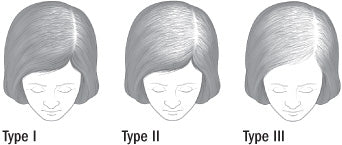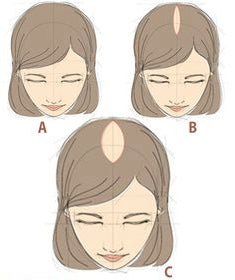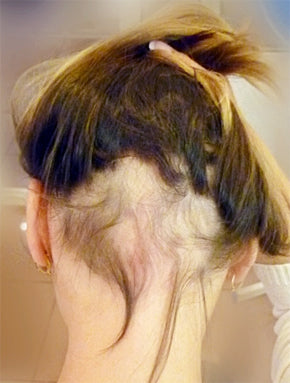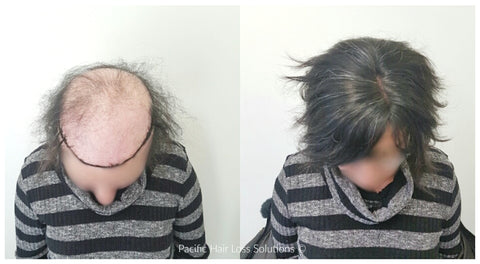Free Consultation
Alopecia
- Home
- Alopecia
Alopecia: Androgenic - Cicatricial (scarring) - Areata - Totalis - Ophiasis - Universalis:
Alopecia is an auto-immune hair loss disease that can be quite sudden often causes a big shock to those who discover it. Those diagnosed with alopecia will often state that a bald spot appeared out of nowhere and gradually grew in size over the course of a matter of months or even years. Typically, only 1-2% of those cases will turn into Alopecia Totalis or Universalis where the sufferer will lose all of their hair, and it is likely it won't grow back.
Androgenic alopecia (female pattern baldness)
Androgenic alopecia is the most common form of alopecia that affects millions worldwide. There are three kinds of female pattern baldness that can manifest even as early as puberty.

Type 1 is generally quite easy to hide simply by parting the hair in a different way. Type 2 showcases decreased volume and noticeable widening in the part. Type 3 is profuse thinning through the part and a 'see-through' appearance throughout the entire scalp.
Alopecia Areata (patchy alopecia)

Alopecia areata often starts in the form of patches throughout all areas of the body but can be most apparent on the head. These patches have the ability in most cases to grow back and sometimes will migrate through the scalp within periods of six weeks to years. Areata is often described as the most unpredictable form of alopecia as it's impossible to determine if the patches will migrate, multiply, re-grow hair or turn into Totalis, as well as how long it will take for any of these options to happen. Though it does sometimes sprout up in adults, alopecia areata often makes itself known within the childhood of sufferers, with an increased likelihood if other family members suffer from it.
Ophiasis pattern alopecia:

Ophiasis derives from the Greek word "ophis", which translates to "snake". The pattern of this alopecia will form in the shape of a snake that will wrap around the lower back and sides of the sufferer's head.
Treatment possibilities:
After the diagnosis, sufferers will look to cortisone shots, topical Minoxidil or anthralin cream to promote growth in their spots or prevent said spot(s) from growing larger. Unfortunately, none of the solutions has the ability to stop other spots from developing. As cortisone is a type of steroid, it does host a list of potential side effects, such as pain at the site of injection, acne, dry skin, thinning skin, insomnia, headaches, dizziness, bloating and changing in shape or location of body fat. Topical treatment side effects include unwanted facial/body hair, tiredness and unusual weight gain. Cortisone injection treatments have a 1% to 24% success rate with regrowth, though there is a high relapse rate for those with more extensive alopecia hair loss. Topical treatments such as Minoxidil and Anthralin have a success rate of 10% to 20%, though are usually more effective for those whose hair loss is recent.
Cicatricial Alopecia
"One day I was scratching my head and came across a scab, I picked at it, but then stopped. Weeks later, I found that that same spot was completely bald and smooth. When I went to go see a specialist they told me I had cicatricial (scarring) alopecia and that my hair was never going to grow back in that area again. I'm about to go on a program that injects cortisone shots into the spot every five weeks. I was told this is meant to stop the baldness from spreading, but not grow the hair back."
This is a very common snippet from sufferers who have just been diagnosed with the not too common cicatricial alopecia.
Scarring alopecia involving hair follicles that are completely destroyed and replaced with scar tissue, creating a thicker surface with permanent hair loss. In most cases, cicatricial alopecia will go unnoticed for months, due to the fact that cicatricial alopecia doesn't showcase any symptoms.
Alopecia Totalis
Alopecia totalis is the most severe case of alopecia, where the sufferer will lose half or all of their hair, sometimes extending to their eyebrows and other parts of the body.
Unfortunately, due to the extent of the hair loss, treatments are often ineffective for restoring hair back to the wearer's scalp. At this time, if the sufferer feels uncomfortable with the state of their they may look into either a synthetic or human hair wig that is fitted to their scalp, styled and coloured to look that is comfortable and incredibly natural looking.
Before and after of a woman suffering from alopecia totalis. She is wearing a fitted full lace human hair wig:

What can Pacific Hair do for me?
Pacific Hair offers holistic solutions such as custom fitted lace closure pieces, or wig sized to provide adequate coverage to the balding spot(s). These systems can be installed semi-permanently, which will allow the wearer to sleep, shower and perform high impact physical activities without worry that it will move around or fall off. If the sufferer is currently seeing a specialist for cortisone injections, we suggest opting for a clip-in or fitted piece, which will allow for easy access by a doctor as well as daily removal. These pieces and wigs are proven to alleviate the stress associated with dealing with alopecia.
Lace hair piece closures are a very versatile option for those suffering from more extensive hair loss. As these pieces are human hair, you have the ability to colour them, wash and heat style with numerous styling tools (blow dryer, flat iron, hot rollers, curling iron). They have a hand-tied hairline, which gives the appearance that the hair is growing directly out of your scalp. You also have the option of changing the part as much as you like. The materials of these bases are practically paper thin, making them very lightweight, breathable and comfortable whether it’s semi-permanent or clip attached. With moderate to heavy use, wearers will find that their human hair lace piece will last up to a year with semi-permanent usage. At that this time, the wearer may find that their piece has lost some volume through natural shedding.
Before and after of a woman suffering from alopecia areata hair loss. She is wearing a semi-permanent lace hairpiece closure:

We offer free consultations (in-person, phone or e-mail) for hair loss solutions for all forms of alopecia.
Who Gets Alopecia Areata?
Anyone can have alopecia areata. It often begins in childhood. There is a slightly increased risk of having the disease if you have a close family member with the disease.
What Causes Alopecia Areata?
Alopecia areata is an autoimmune disease. Normally the immune system protects the body against infection and disease. In an autoimmune disease, the body’s immune system mistakenly attacks some part of your own body. In alopecia areata, the immune system attacks the hair follicles.
The cause is not known. Scientists think that a person’s genes may play a role. For people whose genes put them at risk for the disease, some type of trigger starts the attack on the hair follicles. The triggers may be a virus or something in the person’s environment.
Will My Hair Ever Grow Back?
There is every chance that your hair will grow back, but it may fall out again. No one can tell you when it might fall out or grow back. You may lose more hair, or your hair loss may stop. The hair you have lost may or may not grow back. Even a person who has lost all of his hair may grow all of his hair back. The disease varies from person to person.
How Is Alopecia Areata Treated?
There is no cure for alopecia areata. There are no drugs approved to treat it. Doctors may use medicines approved for other diseases to help hair grow back.
However, none of these treatments prevents new patches of hair loss or cures the disease. Talk to your doctor about the treatment that is best for you.
How Will Alopecia Areata Affect My Life?
Alopecia areata does not make you feel pain and does not make you feel sick. You can’t give it to others. People who have the disease are, for the most part, healthy in other ways. Alopecia areata will not shorten your life, and it should not affect activities such as going to school, working, marrying, raising a family, playing sports, and exercising.
How Can I Cope With the Effects of This Disease
Living with hair loss can be hard. There are many things you can do to cope with the effects of this disease, including:
- Learning as much as you can about the disease.
- Talking with others who are dealing with the disease.
- Learning to value yourself for who you are, not for how much hair you have or don’t have.
- Talking with a counsellor, if necessary, to help build a positive self-image.
Here are some things you can use to reduce the physical dangers or discomforts of lost hair:
- Use sunscreens for the scalp, face, and all exposed skin.
- Wear eyeglasses (or sunglasses) to protect eyes from the sun, and from dust and debris, when eyebrows or eyelashes are missing.
- Wear wigs, caps, or scarves to protect the scalp from the sun and keep the head warm.
- Apply antibiotic ointment inside the nostrils to help keep germs out of the nose when nostril hair is missing.
Here are some things you can do to reduce the disease’s effects on your looks:
- Try wearing a wig, hairpiece, scarf, or cap.
- Use a hair-coloured powder, cream, or crayon applied to the scalp for small patches of hair loss to make the hair loss less obvious.
- Use an eyebrow pencil to mask missing eyebrows.
What Research Is Being Done on Alopecia Areata?
Researchers are seeking a better understanding of the disease. Scientists are studying:
- Genes
- Hair follicle development
- Immune treatments
- Stem cells in the skin
- Medications





